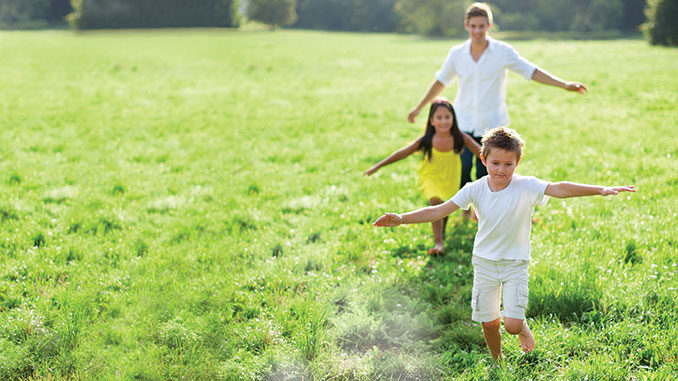
The great outdoors offers a bounty of benefits for kids
Published: March 30, 2022
By: Sandi Schwartz
Have you ever gone on a walk just to clear your mind or taken a “mental health day” from your job to visit the beach, woods, mountains or even a local park? What we all suspected intuitively, science has confirmed: spending time connecting to nature is a safe, effective tool to help minimize the effects of stress and boost mood. It also reduces our response to stress and allows us to recover from tense situations more quickly. Additionally, nature has been shown to improve focus and attention; lower the production of stress hormones like cortisol; and reduce stress-related physical symptoms like high blood pressure, increased heart rate and muscle tension.
A growing number of studies over the past few decades from around the world have shown the importance of nature in improving our family’s health and happiness. Examples cover a broad scope, including recreation activities in the wilderness, community gardens, nature art, views of nature, outdoor exercise, nature-related mindfulness and meditation, and contact with animals.
Why Nature Is Healing
Nature offers a soothing sensory experience like none other. Listening to birds chirping, breathing in the moist air after a rainstorm and walking barefoot on the warm sand are natural treasures that help improve our mood. Studies show that viewing natural scenery like flowers, green plants and woods leads to more relaxed feelings than looking at images with no nature at all. Colors, patterns, textures, scents and sounds are the primary ways we can experience nature through our senses.
The most calming colors stem from nature. Creams, tans, pale blues and pale greens help create a quiet atmosphere. According to color psychology experts, blue calms the mind and body, lowering blood pressure, heart rate and respiration. It also minimizes feelings of anxiety and aggression and creates a sense of well-being. Interestingly enough, blue is overwhelmingly chosen as a favorite color by people around the world. The color green promotes a serene and calming environment and is associated with health, healing and well-being; soothes the body and mind; and reduces anxiety. Neutral colors — tan, beige, ecru, cream, light brown, taupe and gray — manifest an organic, earthy feeling.
We can bring the benefits of nature’s calming colors inside by using more natural hues when decorating our homes. Try using cool colors like blues and greens when choosing décor for your children’s bedrooms since their calming effect help make the room feel spacious and relaxing, like the blue sky or ocean.
How to Build a Nature Habit for Your Family to Feel Happier and Calmer
Nature provides extraordinary wellness benefits. We can connect to nature in so many ways from mindfulness to outdoor exercise to visiting nature centers. A recent groundbreaking study published in Scientific Reports found that spending at least 120 minutes a week in nature is associated with good health and well-being. That’s only about 20 minutes a day.
Not sure how to build a nature habit for your family? The best approach is to start with what they already love and go from there to incorporate more nature into their daily lives.
If they are artistic, consider nature-related art projects since nature is filled with so much beauty to spark creativity in our kids. Ideas include nature photography, drawing and painting nature scenes, writing nature poetry, keeping a nature journal and making up nature songs and dances. They can also engage in a variety of nature art projects using natural items, such as grass weaving, making shell necklaces, collages, mindful rock painting and creating nature mandalas or sculptures.
If they are athletic, sign them up for green exercise, which refers to any activity in which we interact with nature while moving our bodies and breaking a sweat. Some ideas include hiking, swimming, biking, running and outdoor team sports. You can also get creative with an obstacle course in your backyard. You can set it up yourself or have your kids do it. Go through your house and garage and gather a variety of fitness equipment. Put together several stations for different activities, such as a jump rope, cones to weave around, a box to jump over and a basketball net to shoot a ball into. You can also have some stations that do not require equipment; for example, they can do jumping jacks, push-ups or hop on one foot.
If they are adventurous, carve out some time after school, on the weekends and during school breaks to get away to places where your kids can go exploring outside and try new things. Some ideas for adventures include camping, boating, kayaking, river rafting, caving, mountain biking, rock climbing, ziplining, geocaching, skiing, surfing and doing a ropes course.
If they love math and science, get them involved in nature-related science projects. One example is citizen science, which involves volunteering to collect scientific data. It is a way for children to gain science experience and help the scientific community while spending time outdoors in nature. There are citizen science opportunities for kids of all ages and levels. Your family can get involved from your own backyard or through a more organized group like a school nature or science club. Check out http://www.CitizenScience.gov, SciStarter, and Zooniverse to find citizen science projects.
The options are truly endless to build a nature habit that your family will love and benefit from. Just keep challenging yourselves to do more, go a little bit deeper and experience something out of the ordinary. Try new nature activities, visit different places you have never explored and experiment with what brings the most joy and calm to your family. Share your experiences and the tremendous benefits of nature with friends and family so they can benefit as well.
